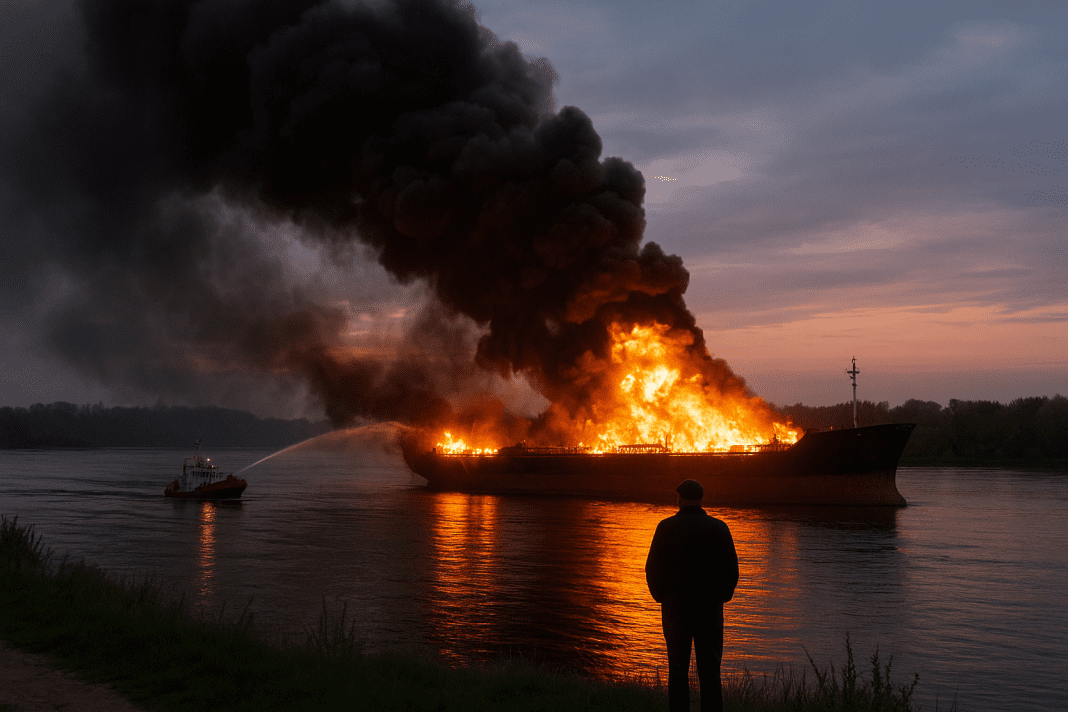A major emergency took place on the Ukraine-Romania border after a tanker carrying liquefied gas was hit during an attack in Ukraine’s Odesa region. The blast happened extremely close to Romania, forcing local authorities to evacuate three villages as a safety measure.
Romania Border Villages Evacuated After Dangerous Blast
The Turkish-flagged tanker was struck while it was offloading gas at a port on the Ukrainian side of the river. The explosion damaged the ship and caused a fire that raised fears of a second blast. Because the tanker contained flammable gas, Romanian officials said the situation carried a high risk.
At least 50 people in one border village were evacuated quickly. Many residents left their homes with pets and farm animals. Emergency teams explained that some houses in Romania were located just a short distance from the river, close enough to feel the danger from the tanker fire.
NATO’s drone wall begins — Poland and Romania deploy Merops to hunt Russian intruders
Two other Romanian villages were also cleared because officials feared that debris, smoke, or heat from the damaged vessel could cross the river. Firefighters, police units, and border rescue teams stayed on-site to monitor the situation closely.
Romania set up temporary shelters for people who had to leave their homes. Buses were arranged to help families move to safer areas. Officers checked every street to ensure no one was left behind. The goal was to keep all Romanian residents far from any possible explosion from the tanker.
Local authorities said this evacuation was needed because the damaged gas cargo made the area extremely unstable. Teams remained in the villages overnight because the risk had not fully passed.
Why Romania Says the Attack Is a Serious Border Safety Threat
The attack sparked strong reactions across Europe because it happened next to NATO territory. Romania is part of the alliance, so any strike near its border raises immediate security concerns.
The evacuation of Romanian residents showed how quickly danger can spill across borders, even when fighting remains inside Ukraine. People living near the river in Romania heard the blast and saw smoke from the Ukrainian side.
Romania on edge as U.S. sanctions threaten to freeze Lukoil’s fuel lifeline
The tanker strike added to growing worries about safety in the Black Sea region. Ports close to Romania and Ukraine have been hit many times during the war, especially in the Odesa area, which sits directly across from Romania.
Because the tanker carried liquefied petroleum gas, the explosion risk was treated as extremely serious. Romanian emergency teams checked air quality, gas levels, and wind direction to keep nearby communities safe.
The incident reminded people that the border remains vulnerable. Over the past year, Romania has held emergency drills as drone parts and explosions from across the river reached its territory. Officials have strengthened safety plans by improving alert systems, tracking river activity, and increasing emergency staff in border villages.
Tanker Damage, Fire Battles, and Rising Regional Tensions
The damaged tanker kept burning after the strike, and fireboats were sent to stop the flames from reaching the gas tanks. The crew escaped safely, but the ship suffered heavy structural damage. Ukrainian teams fought the fire on the port side, while Romania kept its own emergency units ready across the river in case the situation worsened. The biggest fear was that heat could trigger a much larger explosion.
Thick black smoke was visible from several Romanian border communities. Some residents reported the smell of burning fuel drifting into Romania before the wind shifted. Air tests showed safe levels, but monitoring continued.
The strike happened soon after Ukraine agreed to bring liquefied natural gas through ports near Romania, drawing more attention to the area’s growing role in energy transport.
Romania on edge — U.S. troop drawdown sparks security fears along NATO’s frontline
At the same time, several European countries have reported suspicious sabotage attempts on railways, ports, and communication sites linked to support for Ukraine. A recent blast on a railway used to send supplies to Ukraine was also described as a foreign attack, increasing concerns across Europe, including in Romania.
In eastern Ukraine, heavy overnight strikes damaged two major power plants in Russian-controlled Donetsk, leaving many towns without electricity or water. Drone, missile, and artillery attacks were reported across several regions, damaging buildings, energy sites, and transport routes.
With the situation still tense, Romania continues to watch the tanker site and border area closely. The evacuation was one of the most serious cross-border safety operations Romania has carried out since the war began.

